
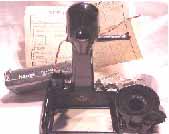


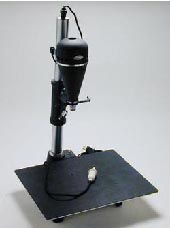

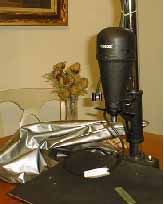
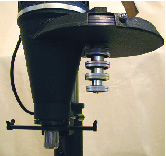


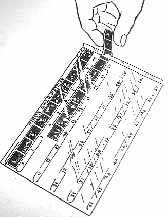


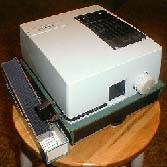
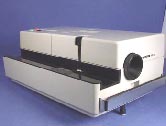

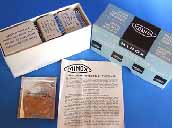
When Walter Zapp and his partners signed the famous contract with VEF of Riga, Latvia for the production of the first Minox there were clauses providing for the design and production of certain accessory items as well, including both the Minox daylight developing tank and a film viewer.
In the years that followed there were to be many fascinating projects to facilitate the turning of little tiny negatives into large, useable images. No one, to my knowledge, has ever produced a comprehensive treatment of the various tanks, enlargers, viewers, processing kits, projectors, and other related items. I am not about to do so either. But here are many of the well known, and more than a few of the obscure accessories and aids for the production of a Minox image.

|
Riga Minox Daylight Developing Tank. They are usually marked "VEF" or "RIGA", or possibly both. Their most distinctive characteristic is the white lining in the spiral. They were apparently not offered with a thermometer, nor were there any spacer rings. The construction is bakelite, so they will be somewhat brittle after 50 years. If you find a complete one with all the original packaging material, sell the farm to buy it. Thanks to Duncan McMorrin at Ebug for this image. |
| Click for Image | Riga film Viewer. It is much like the later film viewer (see below) except made of stainless steel. This was, along with the Riga Enlarger, part of the original contract with VEF. If you "Click for Image" you will see a Riga set at the Latvian Museum of Photography. |

|
Riga Enlarger. From the beginning there was a Minox enlarger; it is only in these degenerate modern times that such a useful item is no longer available from the factory. Note the extensive use of bakelite. The Riga enlarger uses the Riga camera lens as its enlarging element. This particular model seems to be missing the separate transformer, which was also in a bakelite housing. Thanks to Duncan McMorrin at Ebug for this image. |

|
Minox Enlarger model 1. The first post-VEF enlarger, probably less than 1,000 made. In many ways all subsequent enlargers were developments of this model. It is easily distinguished from the later models by the vertical column. Following the lead of the Riga Enlarger, the enlarging element is from the Model II (Model A in Europe) camera then in production. The internal transformer has taps for most common voltages. If you want to shake the confidence of a dealer from whom you are buying any of the postwar enlargers simply ask if the spanner (wrench for assembling the column) is, of course, included. Most were lost decades ago. |

|
Minox Developing Tank. Still being offered by the Minox factory after nearly 50 years, the Minox tank may well lay claim to be the longest continuing production Minox item. The design varies little from the VEF tank, offering daylite loading directly from the Minox cassette. Very early postwar models did not come with a thermometer, then for a time the thermometer was sold seperately. For many years (decades?) the thermometer has come with the tank. At various times the tanks have been sold with none, one, or two spacer rings. These rings are NOT necessary for the operation of the tank, but are a convenience with 15 exposure and 36 exposure lengths of film. The tanks from the 50's and 60's will hold a 50 exposure roll without spacers while the current model will not take anything longer than a 36 exposures. |

|
Minox 2 Enlarger. The most confusing model for the collector as there were continuous improvements and changes. The model II has a film holder that is curved, like the film plane of the IIIs and B. It may have a collimator, or may not. It may or may not have a diffuser. It WILL have a slanted column. An interesting feature of the postwar enlargers is the use of a Dr. Fischer 6 volt bulb with an offset filament. This bulb was quite common in Germany in the 50's and 60's in automotive applications. It has been understandably hard to get for many years now. Image provided by Mr. James Jones. |

|
This Minox copy arm is designed to work with the enlarger by attaching to the column. There was also an insert available that had a 1/4" threaded head to attach any camera with a like tripod socket to the copy arm. These come available only rarely. |

|
Minox 3 Enlarger. If it has a slanted column and if it has a diffuser, and if it has a collimator, and if it has a flat film holder, then it is a Model 3 enlarger. I think. It may be that no one really knows for sure anymore as the changes from the model 2 to the model 3 appear to have been phased in. The one major distinguishing feature is the flat film plane rather than the curved one in the Model II. However, the one pictured at left is said by the owner to have a curved film plane. Image provided by Mr. James Jones. |

|
Minox Color Enlarger. Very scarce, very sought after. The picture shows the most conspicuous change from the model 3: the filters arranged in a pancake disk for color work. |

|
Film Viewer, second style. It was obvious from the start that the very tiny Minox negative would require a special loupe or viewer for even the most casual Minox hobbiest. The version made since the 50's is designed to work with the Minox Film Wallets (see below). This version has the ring below the eyepiece attached by rivets and always has the black knurled ring. |

|
Film Viewer, later style with one piece handle. It was obvious from the start that the very tiny Minox negative would require a special loupe or viewer for even the most casual Minox hobbiest. The version made since the 50's is designed to work with the Minox Film Wallets (see below). If you click on the image at right you will be able to see the little green window that highlights the frame number printed on the film wallet. There are only two versions of this viewer (not counting the Riga), one with a black plastic knurled ring, and one with a grey one. |

|
Minox Film Wallets. These were made to hold the Minox negative and keep them free of scratches and dust. The importance of this is often overlooked by new Minox photographers - a dust speck that is a mote on a 35mm enlargement is a boulder on a Minox enlargement. That such a practical, useful item has been allowed to go out of production defies all logic. |

|
Minox Viewer-Cutters for Transparencies. Designed for the Minox hobbiest to be able to view and accurately cut their own transparencies. Click on the image at left to see two different versions. The earlier version has a little trap door window that allows the cut transparency to fall out. The later version requires a certain Minox slide mount. With this model, you insert the slide mount, line up the transparency with the viewer, and when you squeeze the cutter the transparency falls neatly into the mount. There is said to be a third version of the viewer-cutter, but I have only seen these two. |

|
Minox HP-30 Projector. Surprisingly, this is NOT the earliest Minox projector. There was a US made unit known as the "Hollyslide" from about 1948 to 1952. Not only have I never seen one, I have never known anyone who has. Pictured here is the relatively common, totally manual HP-30 from the late 50s. Works with a two-slide shuttle. |

|
Minox Minomat/Minotact Projector. Pictured here is the Minotact projector offered throughout the 1960's. Both versions take a 36 slide tray. The Minotact is a "semi-automatic" manual focus projector; the slide trays advance "automatically" as you manually move the feed lever in and out. The Minomat has a similar appearance but with the addition of a row of four buttons across the top rear that control the power, slide advance, and the magazine release. A wide range of accessories was made for the Minomat, including both cable and wireless remotes, audio synchronization, automatic slide advance timer, and a fitted case with built-in screen. The Minomat was superseded by the Minomat N, which added autofocusing. |

|
Minox HP-24 Projector. The last, and best of the Minox projectors. The slides now move in an open channel, making it easy to rotate an incorrectly placed slide. All controls are conveniently placed wired remote. There were two versions, the HP-24 and the HP-24A. The HP-24 offered autofocus. |

|
Minox Microfilm Projector. There have been many Minox film viewers made over the years which were designed to be used by government and industry for document retrieval. Some appear to have been purpose-built and were made in very small quantities. This one takes a standard Minox film wallet and projects the image up on the folding screen. The whole assembly closes up to the size of a thick briefcase. The manufacturers plate says the type number is 32-635, it came with a 24X and 48X lens, and appears to date from 1980. I saw this being offered on Ebay; the seller graciously gave permission to use the image. |

|
Minox Developer. If one had all the various kits and packets of Minox developer that were sold over the decades one would have a very large collection indeed. Pictured is a box of Fine Grain developer in packets sized conveniently for the Minox tank. At a guess, this box is from the mid 60's. Image supplied by Klaus Lang. |